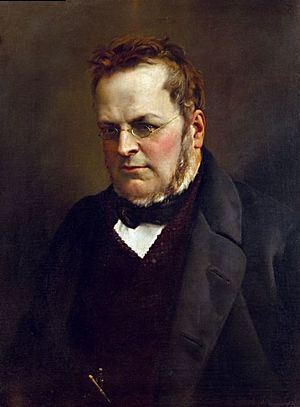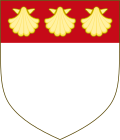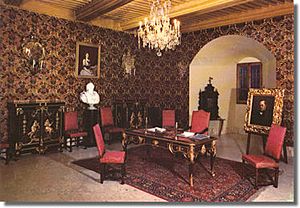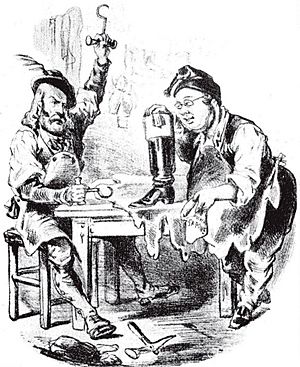Camillo Benso, Count of Cavour facts for kids
Quick facts for kids
The Count of Cavour
SOMHA, OSML, COS
|
|
|---|---|

Portrait by Antonio Ciseri
|
|
| Prime Minister of Italy | |
| In office 23 March 1861 – 6 June 1861 |
|
| Monarch | Victor Emmanuel II |
| Preceded by | Himself as Prime Minister of the Kingdom of Sardinia |
| Succeeded by | Bettino Ricasoli |
| Prime Minister of the Kingdom of Sardinia | |
| In office 21 January 1860 – 23 March 1861 |
|
| Monarch | Victor Emmanuel II |
| Preceded by | Alfonso Ferrero La Marmora |
| Succeeded by | Himself as Prime Minister of Italy |
| In office 4 November 1852 – 19 July 1859 |
|
| Monarch | Victor Emmanuel II |
| Preceded by | Massimo D'Azeglio |
| Succeeded by | Alfonso Ferrero La Marmora |
| Minister of Finances | |
| In office 19 April 1851 – 11 May 1852 |
|
| Monarch | Victor Emmanuel II |
| Prime Minister | Massimo D'Azeglio |
| Preceded by | Giovanni Nigra |
| Succeeded by | Luigi Cibrario |
| Minister of Agriculture and Trade | |
| In office 11 October 1850 – 11 May 1852 |
|
| Monarch | Victor Emmanuel II |
| Prime Minister | Massimo D'Azeglio |
| Preceded by | Pietro De Rossi di Santarosa |
| Succeeded by | Giuseppe Natoli (1861) |
| Member of the Chamber of Deputies | |
| In office 30 June 1848 – 17 March 1861 |
|
| Constituency | Turin |
| Personal details | |
| Born |
Camillo Paolo Filippo Giulio Benso
10 August 1810 Turin, First French Empire |
| Died | 6 June 1861 (aged 50) Turin, Kingdom of Italy |
| Nationality | Italian |
| Political party | Historical Right |
| Signature | |
Camillo Benso, Count of Cavour (born August 10, 1810 – died June 6, 1861), often called Cavour, was an important Italian politician and businessman. He was a key leader in the movement to unite Italy, known as the Risorgimento. Cavour served as the prime minister of the Kingdom of Sardinia (also called Piedmont-Sardinia). He held this role during the Second Italian War of Independence and Giuseppe Garibaldi's efforts to bring Italy together.
After Italy became a united country, Cavour became its first prime minister. He passed away just three months later. He did not live to see Rome become part of Italy in 1870. Cavour helped make many economic changes in Piedmont, which was part of the Kingdom of Sardinia. He also started a political newspaper called Il Risorgimento.
Cavour was elected to the Chamber of Deputies. He quickly became a powerful figure in the Piedmontese government. He became prime minister in 1852. As prime minister, Cavour guided Piedmont through several important conflicts. These included the Crimean War and the Second Italian War of Independence. He also managed the diplomatic efforts during Garibaldi's Expedition of the Thousand. Cavour's skillful diplomacy helped Piedmont become a major European power. The new united Italy was five times larger than Piedmont had been before his leadership.
Contents
Biography
Early Life and Education
Cavour was born in Turin in 1810, when Napoleon's empire controlled the area. His family was wealthy and owned large estates. He was the second son of Michele Giuseppe Benso and Adélaïde Suzanne. Napoleon's sister, Pauline Bonaparte, was one of his godparents.
Camillo and his older brother Gustavo were taught at home at first. When he was ten, Camillo went to the Turin Military Academy. He often had trouble with the strict rules there. He was very independent and disliked the military discipline. In 1827, he joined the Engineer Corps in the Piedmontese-Sardinian army. While in the army, he learned English and studied the ideas of liberal thinkers. These ideas made him a bit suspicious to the authorities.
In 1831, Cavour left the army because he found military life boring. He also disagreed with the king's strict policies. He then managed his family's estate at Grinzane. He served as mayor there from 1832 until 1848.

After leaving the army, Cavour traveled a lot. He visited Switzerland, Paris, and London. In Paris, he was very impressed by the political debates. This made him want a career in politics even more. He also toured parts of England, the Netherlands, and Germany.
Cavour believed that economic growth was important before political change. He strongly supported building railroads in Italy. He thought steam engines were very useful for transportation. Between 1838 and 1842, Cavour started many projects to improve the economy in his region. He tried new farming methods on his estate, like growing sugar beets. He was also one of the first Italian landowners to use chemical fertilizers. He founded the Piedmontese Agricultural Society.
Starting a Political Career
In 1848, new liberal ideas spread across Italy. This allowed Cavour to enter politics without fear. He gave a speech supporting a constitution for Piedmont, which was later granted. At first, Cavour was not offered a position in the new Chamber of Deputies. He was still seen as a somewhat suspicious figure.
Cavour did not initially plan to create a fully united Italy. His goal was to expand Piedmont by adding regions like Lombardy and Venetia. He was known as a progressive leader who was not revolutionary. Cavour was not a great public speaker. He lost the next election. Meanwhile, the Piedmontese army was defeated at the Battle of Novara. This led King Charles Albert to give up his throne to his son, Victor Emmanuel II.
Cavour was later re-elected to Parliament. He became very successful there. His knowledge of European markets and modern economics helped him greatly. In 1850, he became Minister of Agriculture, Commerce, and the Navy. Cavour quickly became a dominant figure in the government of Prime Minister Massimo d'Azeglio. He brought together moderate politicians from different groups in Parliament. In 1851, Cavour became Minister of Finance. He used this role to start a large railway expansion program. By 1860, Piedmont had 800 kilometers of railway track. This was one-third of all the railways in Italy at that time. He also led efforts to reduce the power of the Church. This made him popular with liberal groups across Italy.
Prime Minister of Piedmont–Sardinia
In November 1852, Cavour formed a political alliance called the Connubio (meaning "marriage"). This alliance brought together moderate politicians. It led to the fall of the d'Azeglio government. The King, Victor Emmanuel II, reluctantly accepted Cavour as prime minister. Their relationship was often difficult.
Cavour believed in free trade, freedom of speech, and a government separate from the Church. However, he was against republicans and revolutionaries. He saw them as disorganized and a threat to social order. Cavour was a strong leader in Parliament. He spent a lot of money on modernizing projects, especially railways. He also invested heavily in the army and navy. This caused the national debt to increase significantly. When he became prime minister, Piedmont had just lost a major war to Austria. By the time he died, Victor Emmanuel II ruled a much larger state. This new state dominated Italy and was considered a major European power.
Britain and France asked Piedmont to join the Crimean War. Cavour hoped that these allies would support Piedmont's expansion in Italy. He agreed to join the war on January 10, 1855. Piedmont sent 18,000 soldiers. Although they did not play a huge military role, this participation earned Piedmont a seat at the Congress of Paris. This meeting ended the war.
In 1858, an Italian named Felice Orsini tried to assassinate Napoleon III of France. This event, surprisingly, opened up talks between France and Piedmont. While in prison, Orsini wrote a letter to Napoleon III. He urged the Emperor to help make Italy independent. Napoleon III then began to consider working with Piedmont against Austria. Cavour and Napoleon met in July 1858. They agreed that Piedmont would try to start a war with the Duchy of Modena. This would force Austria to get involved, and France would then help Piedmont. In return, Cavour agreed to give Savoy and Nice to France. These were territories historically linked to the Piedmontese royal family.
Both France and Piedmont prepared for war. However, diplomatic support for their plan quickly faded. Napoleon III became less enthusiastic. Britain, Prussia, and Russia suggested an international meeting. One goal was to disarm Piedmont. Piedmont was saved when Austria sent an ultimatum on April 23. Austria demanded that Piedmont disarm itself. This made Austria look like the aggressor. France then began to move its troops into Italy. Piedmont had to defend itself for a short time. Luckily, bad weather and Austria's slow decisions gave France time to arrive with a large force.

The battles of Magenta and Solferino gave Franco-Piedmontese forces control of Lombardy. However, the Austrians still held strong fortresses. These defenses, the terrible fighting at Solferino, and the risk of Prussia joining the war made Napoleon sign a separate peace with Austria. This was the Treaty of Villafranca on July 11, 1859. It ended the Second Italian War of Independence. Victor Emmanuel accepted the peace. Cavour was so angry about the treaty's terms that he resigned.
However, Cavour soon became hopeful again. Many parts of the treaty, like restoring the old rulers of Tuscany and Modena, were not carried out. Also, an Italian Confederation that included Austria was not formed. General La Marmora took over as prime minister. He tried to follow the treaty. But the rulers of the central Italian states wanted to unite with Piedmont.
Cavour returned to politics on January 20, 1860. He agreed with Napoleon to give Savoy and Nice to France. In return, Tuscany and Emilia would join Piedmont. Public votes (plebiscites) were held in these regions. The people voted overwhelmingly to approve the changes. Cavour convinced most people that uniting Italy was worth these territorial losses. This completed the first step of Italian unification.

Giuseppe Garibaldi was angry that his hometown, Nice, was given to France. He wanted to take it back. But a rebellion in Palermo, Sicily, in April 1860, turned his attention south. Cavour refused Garibaldi's request for Piedmontese troops to take Sicily. So, Garibaldi gathered a force of a thousand redshirt volunteers. They landed in Sicily on May 11. They won battles and gained control of Sicily. Cavour tried to add Sicily to Piedmont, but Garibaldi refused.
Cavour convinced Victor Emmanuel to write a letter to Garibaldi. The letter asked him not to invade mainland Italy. The King sent the letter, but secretly wanted Garibaldi to invade. Cavour then tried to start a liberal revolution in Naples, but the people there were not interested. Garibaldi invaded Naples anyway, entering the city on September 7. He declared Victor Emmanuel the King of Italy. Garibaldi became the military leader of southern Italy and Sicily. He adopted the Piedmontese constitution but publicly demanded that Cavour be removed. This created some tension with Victor Emmanuel.
Garibaldi wanted to invade the Papal States next. Cavour feared France would declare war to protect the Pope. He successfully stopped Garibaldi from attacking. Garibaldi's forces were weakened by the Battle of Volturno. Cavour quickly invaded the Papal regions of Umbria and Marche. This connected the territories controlled by Piedmont with those taken by Garibaldi. The King met with Garibaldi, who handed over control of southern Italy and Sicily. This action finally united Italy.
Cavour and Garibaldi often disagreed. Cavour once called Garibaldi "a savage." Garibaldi famously called Cavour "a low intriguer."
Prime Minister of Italy
In 1861, Victor Emmanuel II declared the Kingdom of Italy. Cavour became the first Prime Minister of Italy. He faced many challenges. He had to create a national military and decide which laws to keep. The future of Rome was a major issue. Most Italians believed Rome should be the capital of a united Italy. However, this conflicted with the Pope's power and the independence of the Church. Cavour believed Rome should be the seat of "a free church in a free state." This meant the Church would be independent but give up its political power. These issues were known as the "Roman Question".
Another problem was Venetia, which was still controlled by Austria. Cavour knew Venice had to be part of Italy. He said, "Will the deliverance of Venice come by arms or diplomacy? I do not know. It is the secret of Providence." A vote in Parliament strongly supported his foreign policy.
Creating Italy was a huge task. Ruling it proved even harder for Cavour. In 1861, at the height of his career, long days and constant worry took a toll on him. He became ill, likely from malaria, and passed away. He was buried in Santena, near Turin.
After his death, Italy gained Venice in 1866 during the Third Italian War of Independence. The Capture of Rome in 1870 completed the unification of Italy.
Legacy
Today, many Italian cities have important streets, squares, and metro stations named after Cavour. These include Turin, Trieste, Rome, Florence, and Naples. Several ships have also been named in his honor. These include the clipper ship Camille Cavour, the battleship Conte di Cavour (which fought in both World Wars), and the modern aircraft carrier Cavour.
In 1865, the Collegio dei Nobili, a very old and famous high school in Turin, was renamed the Liceo Ginnasio statale "Camillo Benso di Cavour" (now known as Liceo classico Cavour).
See also
 In Spanish: Camillo Benso, conde de Cavour para niños
In Spanish: Camillo Benso, conde de Cavour para niños




